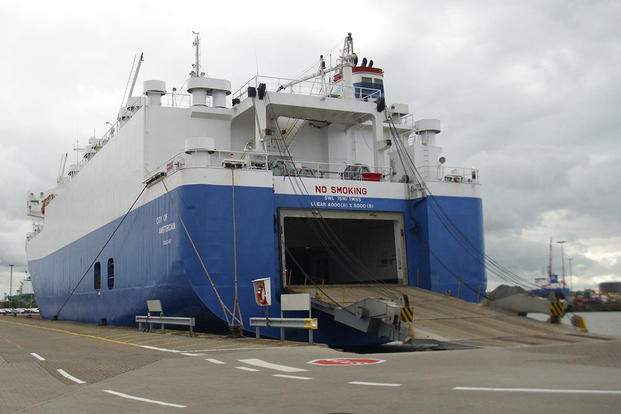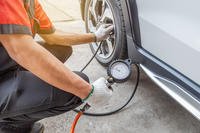If you've received a new assignment and have decided to leave your personal vehicle (or POV as they say in the military) at home, there's a few insurance options available to you (see this article for more details). But if you're keen on taking your car with you to your new duty station, or bought a POV overseas while stationed there and want to ship it home, get familiar with the rules below — you may be able to ship your vehicle at no cost to you.
Hot Links:
https://www.pcsmypov.com - Official site for checking on the status of your POV during shipmentPOV Shipping Checklist and Forms - Our rundown of important details to keep track of during the POV process, and links to important forms.
1. The Rules:
You are eligible to ship a single POV if:
- you are a member of the U.S. armed forces;
- you are a DoD civilian and your orders authorize shipment of your POV; or
- you are a retiree authorized to ship a POV.
The entitlement to ship a single POV is limited to a permanent change of station to, from, or between places overseas; or upon official change in homeport of the vessel to which you are assigned.
Only one POV owned or leased by you or your dependent and for your personal use may be shipped to your new duty station at government expense. If you want to ship an additional POV commercially, you should check with your sponsor and transportation office for any restrictions. You may have to pay an import duty on a second POV.
2. Vehicle Limitations
Only self-propelled, wheeled motor vehicles can be shipped. This includes automobiles, station wagons, jeeps, motorcycles, motor scooters, vans, and pickups. Other passenger-carrying, multipurpose motor vehicles designed for overland ground transportation not specifically listed above may qualify, but may require written certification stating the vehicle is for personal use as a passenger-carrying vehicle. POVs that are modified to be "low riders" must have at least 6 inches of clearance to prevent damage to POV during car carrier load/download. Also, POVs may not have a lift kit higher than 3 inches.
Note: Host-country restrictions may apply; see your transportation office for details.
You can ship a POV up to 20 measurement tons (exceptions could be granted for medical reasons). A measurement ton equals 40 cubic feet. Just for reference, a compact car averages about nine measurement tons and a full size car, about 15. If you ship a pickup truck with a camper, a recreational vehicle, a panel truck converted to a camper, or similar vehicle that exceeds 20 measurement tons, you'll be liable for extra transportation costs.
Tip: Exterior dimensions are included in the size of a vehicle, so remove truck mirrors and other attachments that extend from the vehicle to help cut down on the vehicle's size.
3. Insurance and Licensing
Returning to the United States: In some U.S. states, armed forces or host-nation vehicle registrations, license plates, and licenses either are not valid or are valid for only a very short time. Arrange to obtain these items prior to taking delivery of your POV. Most state motor vehicle divisions will accept registrations of POVs by mail.
If you are returning from overseas, make arrangements before leaving your old duty station for the continental United States. You should insure your POV before taking delivery. Coverage must meet minimum requirements prescribed by the state where your next duty station is located. Prior arrangements may save you money, as you will be able to compare prices offered by various insurance companies.
Shipping Overseas: Insurance, taxes, and licensing vary from country to country overseas. The best sources of information are your local transportation office and your overseas sponsor. Remember, you're responsible for obtaining insurance and licenses and paying any taxes. Be sure to check on these items well in advance of making your shipment. Insurance is often much more expensive overseas, so be sure to do your research before making your shipment.
4. When to Ship Your POV
Army and Air Force personnel:
- POVs will be accepted for shipment if delivered to the port within 90 days after the member or dependent has departed for an overseas tour of more than one year, or within 30 days after the departure of the member on an overseas tour of duty of one year or less.
- When delivery to the port is delayed beyond 90 days, the POV may be shipped only with the approval of the overseas commander. For overseas tours of more than one year, you must have a minimum of one year to serve on the current overseas tour when the POV is delivered to the port.
For Navy/Marine Corps personnel:
- POVs will be accepted when at least 12 months remain to be served at the servicemember's current overseas duty station at the time the vehicle is delivered to the loading port. An exception is allowed if the overseas area commander or your commanding officer certifies the vehicle is necessary in performance of official duties.
5. What You Can and Can't Ship in Your POV
Only authorized personal articles can remain in your POV when it is turned in for processing. All household items and camping equipment must be removed.
What you can ship in your POV:
- Tools under $200 in total value
- Items such as jacks tire irons, tire chains, fire extinguishers, nonflammable tire inflators, first aid kits, jumper cables, and warning triangle/trouble lights
- One spare tire and two snow tires with wheels (either mounted or unmounted)
- Portable cribs, children’s car seats, and strollers
- Luggage racks and supports
- Small items such as thermos bottles, bottle warmers, and car cushions if they can be packed entirely within one carton provided by the Vehicle Processing Center (VPC). If your POV is going to be containerized at the port, these articles can be placed in the trunk without a carton
- Factory or non-factory stereo, speakers and audio/video equipment in POV or trunk must be bolted down or permanently fixed as part of the POV
What you can't ship in your POV:
- TVs, VCRs and DVD players, except factory or permanently installed
- Accessories not permanently installed
- Flammable or hazardous substances such as waxes, oils, paints, solvents, or polishes
- Any liquids (i.e., antifreeze or air fresheners) that may be spilled and leave stains
- Any pressurized cans
- Citizen Band (CB) radios — importation and operation of CB radios are prohibited in most overseas areas
Failure to comply with these restrictions may result in your POV being held at the port of discharge until such equipment has been removed and shipped out of the country. All costs associated with removing your CB radio from your POV and shipping will be at your expense.
For more details and to get your shipment process started, contact your nearest Vehicle Processing Station:
Tracking Your POV
You can track your POV through the PCSMyPOV website. Just enter your name, Social Security number, and order number and you can find out just where your vehicle is in the moving process. Directions and maps to the vehicle pick-up centers and more detailed information on shipping a vehicle can be found on this site, as well.











